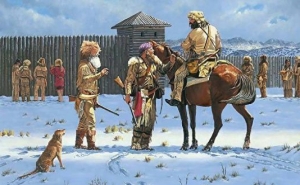 This is a true story. It happened to me about 2 years ago. I didn’t know it then, but it has so much more relevancy today.
This is a true story. It happened to me about 2 years ago. I didn’t know it then, but it has so much more relevancy today.
It was 8 am. I was on my way to my secret, picker’s breakfast. A hidden country place that serves up a platter of grub that stays with you until dark. A place where pickers eat, and their meals are paid for by the farm they work. This story though, isn’t about eating a big breakfast.
On the back road, I pulled over next to a big wagon filled with just-picked peppers, and another wagon filled with new baskets I thought would make a great sketch study. There was nobody around, just acres and acres of perfect peppers, and the fresh, intense scent literally pulled me deep into the field. I looked around and filled my lungs. I couldn’t believe how great the scented air was. The humidity almost turning the wonderful scent into a taste. I felt so privileged to be standing out here.
Just then, from out of nowhere, this wonderful old farmer approaches me from behind. I could hear the scuff of his boots in the soil. “What are you doing here?” He asked sternly. Turning around defensively, and with a smile I said, “Hi, I love the smell of peppers…I just had to experience it. Hope you don’t mind. Do you ever get tired of this, of the goodness you’ve made here? The scent is so wonderful!” He stared at me through squinted eyes for what seemed like forever. His gaze went deep into me, I could feel him searching for an understanding. I stared back. “Got a minute?” he said.
We were bouncing along in his old pick-up. Ancient country played on the radio, and I could feel him sizing up me up, sizing up my character. I’m sure the feeling was much like what Dreyfus felt when tying his sheepshank for Quint. I even half expected him to want a look at my hands. “What do you do?” he asked. Oh boy, here we go. He’s never going to understand this. I mean this old guy was tough, and lived a rough life from dawn to dusk. I was about to answer when we slid to a stop in front of this huge corn field. Without a word, he jumped out leaving his door open. Leaving the door open — yeah, this guy could write a book on swag. I followed him into the field.
Already I loved this guy. It’s early morning and he’s got a year’s worth of crust on his hands and clothes. When he moved, you could see bits of dirt, leaves and dust falling off and building its own environment around him. The deep crevices of his tan face were heavily painted with dirt and dried sweat. I desperately wanted to sketch his portrait. He stopped, then looked at me. I waited. I could see him smelling his field in deep breaths. “You talk about smell…can you smell it?” He said. I took a deep breath. “Oh yeah…wonderful.” I said. “Can’t you smell it!? Can’t you smell what they’ve done?” I took another deep breath, paused and then looked at him confused. “A corn field used to communicate through it’s smell. Every farmer knows that. You could smell how good the field was, when it needed water, when it begged for sun, or even when it was ready…just from the way it smelled. Now corn produces it’s own crap to keep it perfect…and it’s own ugly smell. I never sprayed my crops, never liked it, and my vegetables used to have a look. A look that showed how they struggled for life and how they won. Water is all I have to do now. Can’t you smell it?” I didn’t answer, and he continued as if he sensed his mortality.
“Yeah, I have grandkids…they don’t want this. They don’t understand it. When I saw you spinning in my peppers I thought you understood.” “I wasn’t spinning…really.” I said quickly.
But I did understand. I wanted to tell him that’s what made me stop in the first place. We shook hands at the end. I wanted to hug him, to let him know, but his ruggedness would probably get in the way.
What will we do when all these great old farmers are gone? When their grandsons, never having smelled pure corn, are running farms growing genetic monsters. Gone will be the peppers that used to ripen with love and nature, and prove their struggled journey with imperfect perfection. We will soon lose these heroes of pure farming, and the crops they once grew. Science will kill them all, and turn what farming remains into soulless geneticism.



